
Vintage Newmarket Transistors Packaged Circuits
This page ©2021 Andrew Wylie all rights reserved



This page is about the smallish circuit boards containing germanium transistors that were sold by Newmarket Transistors Ltd in the 1960s and 70s. These are described in their Product Portfolio from 1962.
For those who just want to go straight to the point, here are the relevant pages from the Portfolio:
Although I believe that these devices use Newmarket transistors, most of them are not branded and are not marked from Newmarket's standard product ranges. I do not have data for these idiosyncratically numbered transistors.
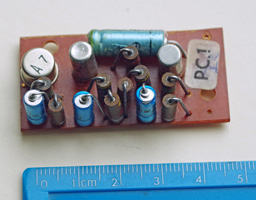
Here is an example of PC1, described as a 'miniature medium-impedance high-gain general purpose audio amplifier'. Its output maximum is 150 mW into 40 ohms, quite a high-impedance load. The image shows one transistor printed A7; such numbering is typical of the devices on the PC boards.
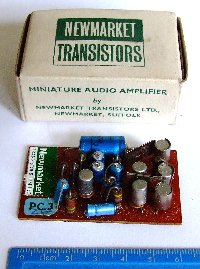
Here is a PC3 with its box. The PC2 to PC4, all described as a 'miniature low-impedance high-gain audio amplifier', seem to be essentially the same circuit with only a change (of probably one or two resistors) at the input, which results in the different sensitivities. They can provide 400mW into 15 ohms.
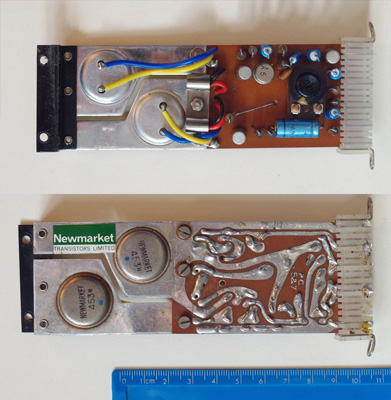
I have two examples of this board (both sides shown), one marked 'PC5+' and the other 'PC5&7'. These numbers are somewhat odd. but it is clearly a PC5, described as a 'miniature high-power medium-impedance high-gain audio amplifier'. It is unusual in that the power transistors are printed 'NEWMARKET 453'. However, that device normally has a TO-3 outline; these ones appear to just be the central round part without the diamond 'skirt'. It provides 3 watts into 3 ohms.
I have now found an article in 'Wireless World' January 1964 that includes an explanation of the + symbol:
A MINIATURE audio amplifier suitable for the audio stages of a car radio receiver, high-power domestic radio and record player is available from Newmarket Transistors Ltd., Newmarket, Suffolk. The power requirement of the amplifier, which is transformerless, is 12 V (direct). The input impedance is 1 kΩ and two versions, differing in sensitivity, are available. The PC5 requires an input signal of 50 mV r.m.s. for 3 W output, the PC5+, 5 mV for 3 W output. At this output, and with a lkc/s signal, the total distortion is 3%. The frequency response extends from 50 c/s to 15 kc/s. The amplifier operates satisfactorily over a temperature range of 0 to 45° C. Weighing only 2 oz, the dimensions are 5½, x 1¾, x ¾ in.
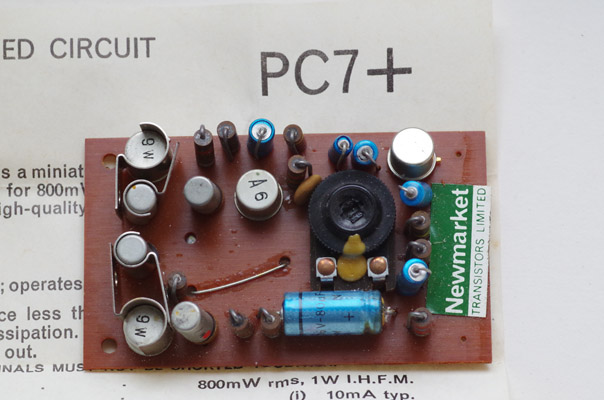
PC7+ is described as a 'miniature medium-impedance high-gain audio amplifier'. A correspondent kindly sent me one with its data sheet.
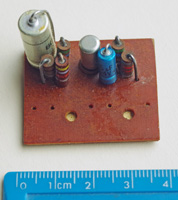
This PC9 is the smallest of the range and is described as a 'high-to-low impedance matching preamplifier'.

The PC10 is described as a 'magnetic replay head amplifier'. I presume this means that it has a suitable frequency response to provide equalisation of a signal from a tape-head. I do not have one.
PC101 is an 9V 100mA unregulated power supply, PC102 is a 22V 330mA unregulated power supply, and PC106 is a 12V 500mA unregulated power supply. These are all just transformers with an apparently-unmarked metal rectifier (Newmarket did not make diodes) and one or two smoothing capacitors. I don't think there are any Newmarket components in these, the company just sold them to complement the PC cards. I don't have any of them.
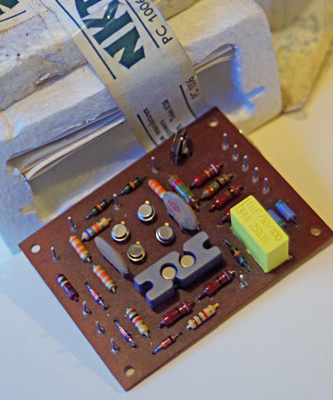
I also have this more modern-looking card in its Newmarket packaging with a product-specification leaflet that calls it a 'PC1006 meter pre-amplifier'. Again the transistors are not marked NKT types, but look more modern. I have no data for this card. If you know more about it, or other PC types not shown here, please